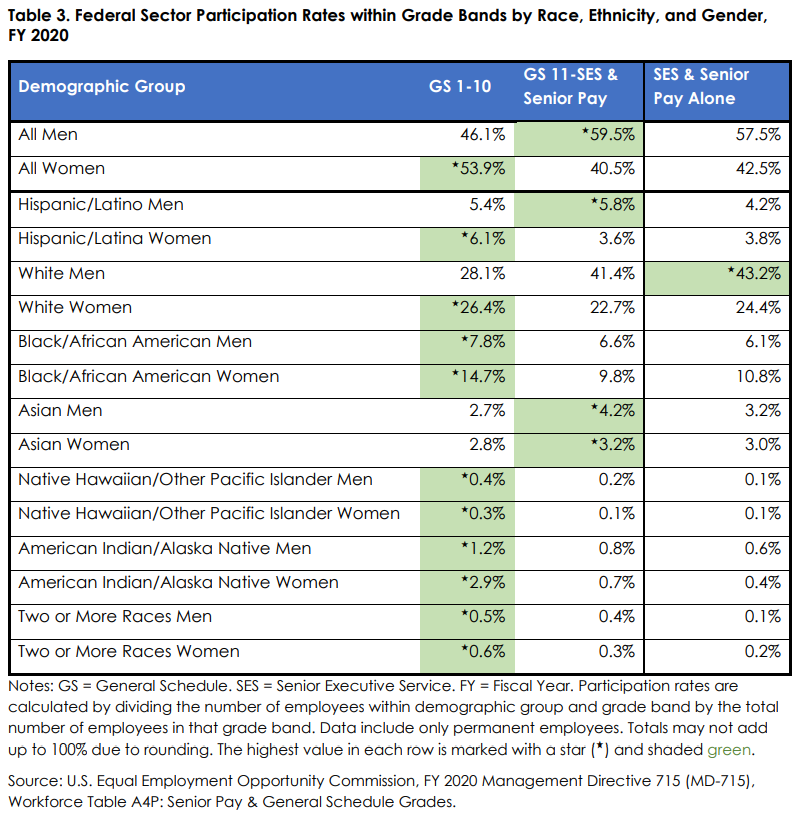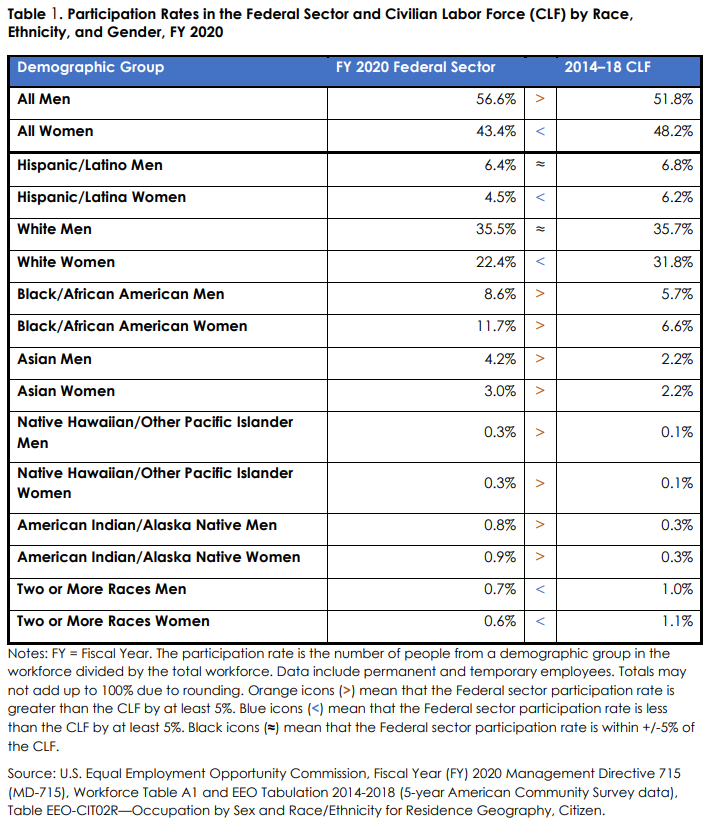
Higher federal workforce diversity is often concentrated in lower pay grades
Although agencies have made progress in promoting equal employment opportunities, the EEOC's latest federal workforce report shows that some inequities still ex...
Although agencies made progress in promoting equal employment opportunities, inequities still remain in the demographic makeup of the federal workforce.
There were improvements in federal workforce diversity overall between fiscal 2016 and fiscal 2020, but most demographic groups were more prominently found in the lower ranks of the General Schedule (GS), the Equal Employment Opportunity Commission said in a March report.
Looking higher up on the GS scale and in the Senior Executive Service (SES), the federal workforce becomes less diverse.
“Overall, men disproportionately held GS-11 through SES and senior pay positions (59.5%), as well as SES and senior pay alone positions (57.5%),” EEOC said in the report. “By comparison, women accounted for only 40.5% of GS-11 through SES and senior pay positions, and 42.5% of SES and senior pay alone positions. Women accounted for over half (53.9%) of GS 1-10 positions.”
Specifically, Hispanic and Latina women have increased their participation in the federal workforce, moving from a 3.7% participation rate in 2016, to 4.5% in 2020. Overall, EEOC said the increase was “encouraging.”
But for positions in GS-11 and above, as well as in the Senior Executive Service (SES), the composition looks different. Hispanic and Latina women make up 6.1% of employees between GS-1 and GS-10, but just 3.6% of higher GS levels and the SES.

White men, Asian men, Asian women and Hispanic and Latino men are the only groups that have higher participation rates in the upper rankings of the federal workforce than they have in the GS 1-10 range, EEOC said.
EEOC’s report, which compiled data from fiscal 2020, expanded the workforce data to include comparisons over the past five years. The commission said it hopes the additional context will help agencies better understand differences among race, ethnicity, gender and disability groups for the federal workforce.
“We continue to see slow but steady progress in the federal sector with regard to key indicators of the EEOC’s mission to prevent and remedy unlawful employment discrimination and advance equal opportunity for all,” Carlton Hadden, director of EEOC’s Office of Federal Operations, said in a statement.
To try to balance out some of these inequities, agencies should identify “promising practices” for recruitment and retention of employees where there have been improvements, EEOC said, and use those for other categories as well. The practices can include, for instance, mentoring programs at agencies.
“Better recruitment, retention and opportunities for advancement present opportunities to improve equity in the demographic composition overall and in higher-level positions,” EEOC said in the report.
Additionally, despite most groups increasing their representation in the federal workforce, white women, men of two or more races and women of two or more races all saw decreasing federal workforce participation in 2020, compared with four years earlier.
“Federal agencies with low and/or declining participation rates … should find and address the root causes,” EEOC said. “Recruitment, hiring and retention should be made central in these barrier analyses.”
Most demographic groups also had higher participation in the federal workforce than they did in the civilian labor force (CLF). The definition of CLF is somewhat complicated, but generally refers to the non-federal, non-military nationwide workforce.
The two largest disparities, though, were white women, as well as Hispanic and Latina women, which both comprised significantly lower portions of the federal workforce, compared with the nationwide workforce.

Leaders of the Department of Justice Gender Equality Network (DOJ GEN), an employee-run federal workforce advocacy group, found the results of the EEOC report unsurprising.
“The data outlined in the EEOC’s report reflects what nearly all federal employees already know — that women, and women of color in particular, are still underrepresented in the upper echelons of government,” DOJ GEN board member Liza Zamd said in an email to Federal News Network. “Agencies must address the discrimination and stereotypes behind these disparities by implementing the administration’s DEIA directives with the urgency they demand.”
Beyond race and gender, equal opportunity encompasses other types of diversity — EEOC’s report, for example, also considers the participation rates of individuals with disabilities in the federal workforce.
There has been some progress in this area, EEOC said. A vast majority of agencies — about 92% — reported they are prominently posting their accommodation procedures for employees with disabilities. And employees with disabilities continue to increase their participation of the federal workforce overall.
“However, their participation is concentrated in lower pay grades. Federal agencies must continue their efforts to recruit, advance and retain employees with disabilities and targeted disabilities,” EEOC said.
Agencies generally fell short of their goals for participation of employees with disabilities in GS-11 and above, as well as in the SES, EEOC said.
“Federal agencies must not only aim to increase the participation of [individuals with disabilities], but they must set and assess goals for the participation … in lower and higher pay grades,” EEOC said.
The data in the report has limitations as well. For one, the departments of the Army, Transportation and Veterans Affairs did not certify their reports. The missing data can cause inaccuracy and fluctuations in the governmentwide numbers and percentages, EEOC said.
“Although only a snapshot, this data helps indicate how federal agencies can enhance their ongoing efforts to make the federal government a model employer free from unlawful discrimination,” EEOC Chairwoman Charlotte Burrows said in a statement.
Agencies will continue receiving assistance from EEOC, including technical help, training and outreach, to try to get closer to these equal employment opportunity goals.
“Although progress is evident, federal agencies should continue to strive to achieve full EEO and become model employers,” EEOC said.
Copyright © 2024 Federal News Network. All rights reserved. This website is not intended for users located within the European Economic Area.
Drew Friedman is a workforce, pay and benefits reporter for Federal News Network.
Follow @dfriedmanWFED





